-
连续/离散的控制系统阶跃测试(包括MATLAB里的step()函数)
阶跃测试
只要是连续时间系统,无论是传递函数还是连续状态空间形式的模型,直接可以用**step()**做阶跃测试;但是对于离散系统而言,不能用step()函数,可以自行编写代码,如下。
1、离散系统:x(k+1)=Ax(k)+Bu(k)

离散系统阶跃响应不能用step()函数,可以自行编写close all; clear all; A=[1.1 2;0 0.95];B=[0;0.079]; total = 100; x = zeros(2,total+1); u = zeros(1,total); u(1) = 1; t = zeros(1,total); for i=1:total t(i) = i-1; x(:,i+1) = A*x(:,i) + B*u(:,i); end figure(1); subplot(3,1,1); plot(t,x(1,1:total)); ylabel('x1') hold on; grid on; subplot(3,1,2); plot(t,x(2,1:total)); ylabel('x2') hold on; grid on; subplot(3,1,3); plot(t,u(1:total)); ylabel('u') hold on; grid on;- 1
- 2
- 3
- 4
- 5
- 6
- 7
- 8
- 9
- 10
- 11
- 12
- 13
- 14
- 15
- 16
- 17
- 18
- 19
- 20
- 21
- 22
- 23
- 24
- 25
- 26
- 27
- 28
- 29
- 30
- 31
- 32
- 33
- 34
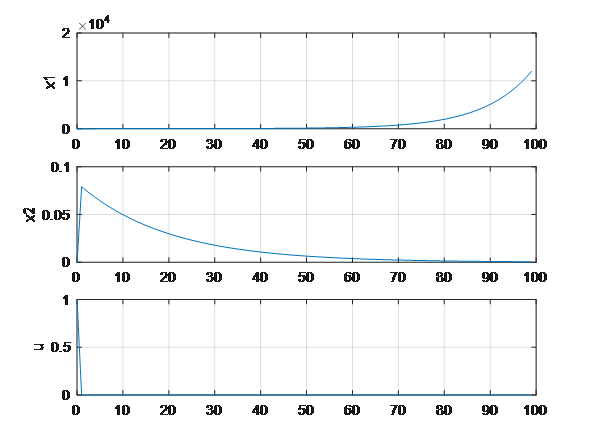
可见系统自身不稳定,因为离散系统的特征值有在单位圆外,如下
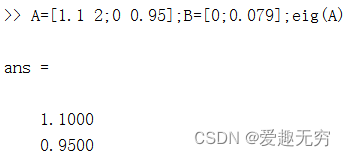
2、连续系统:x’=Ax+Bu或y=G(s)u
一个是连续状态空间模型,一个是传递函数模型
2.1 传递函数形式:

MATLAB里写成传函形式,并做阶跃测试**step()**函数
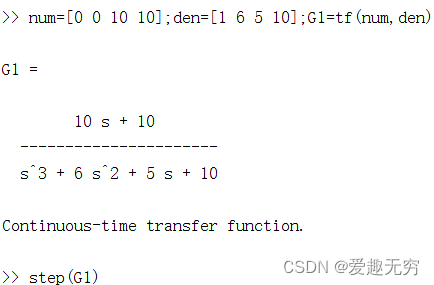
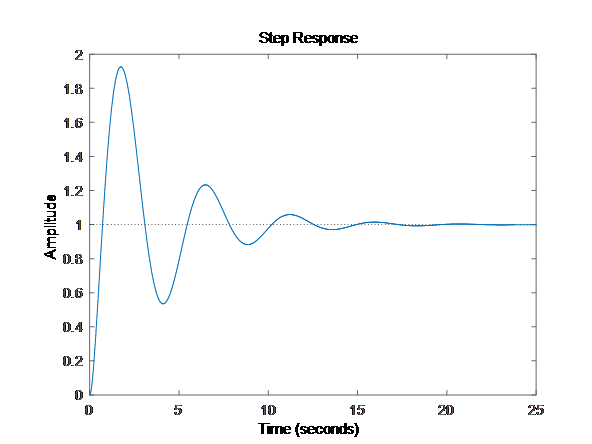
2.2 化成连续状态空间形式

再做阶跃

不管是传函,还是连续状态空间,step()测试结果相同,说明系统稳定,因为状态矩阵特征值都<0;eig(A)
ans =
-5.4178 + 0.0000i
-0.2911 + 1.3270i
-0.2911 - 1.3270i2.3 连续状态空间形式化成离散状态空间形式
(1)对传递函数进行离散
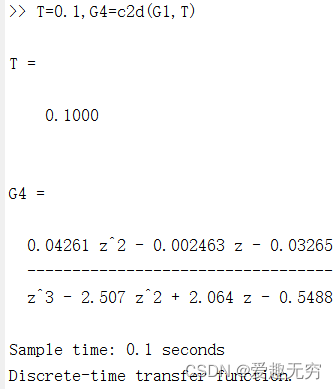
得到的是离散时间传递函数,z变换
(2)对连续状态空间模型进行离散

得到的是离散状态空间模型
(3)对离散状态空间模型做阶跃测试
离散系统阶跃响应不能用step()函数,可以自行编写,就是本文第1节,下面继续写一遍:A = [0.5307 -0.2069 -0.1864;0.1491 0.978 -0.02058;0.01647 0.1985 0.9986];B = [0.1491;0.01647;0.001152];C = [0 2.5 1.25];%得到的离散状态空间模型 total = 100; x = zeros(3,total+1); u = zeros(1,total); u(1) = 1; y = zeros(1,total); t = zeros(1,total); for i=1:total t(i) = i-1; x(:,i+1) = A*x(:,i) + B*u(:,i); y(:,i+1) = C*x(:,i+1); end figure(1); subplot(3,1,1); plot(t,x(1,1:total)); ylabel('x1') hold on; grid on; subplot(3,1,2); plot(t,x(2,1:total)); ylabel('x2') hold on; grid on; subplot(3,1,3); plot(t,x(3,1:total)); ylabel('x3') hold on; grid on; figure(2) subplot(2,1,1); plot(t,u(1:total)); ylabel('u') hold on; grid on; subplot(2,1,2); plot(t,y(1:total)); ylabel('y') hold on; grid on;- 1
- 2
- 3
- 4
- 5
- 6
- 7
- 8
- 9
- 10
- 11
- 12
- 13
- 14
- 15
- 16
- 17
- 18
- 19
- 20
- 21
- 22
- 23
- 24
- 25
- 26
- 27
- 28
- 29
- 30
- 31
- 32
- 33
- 34
- 35
- 36
- 37
- 38
- 39
- 40
- 41
- 42
- 43
- 44
- 45
- 46
- 47
图形如下:
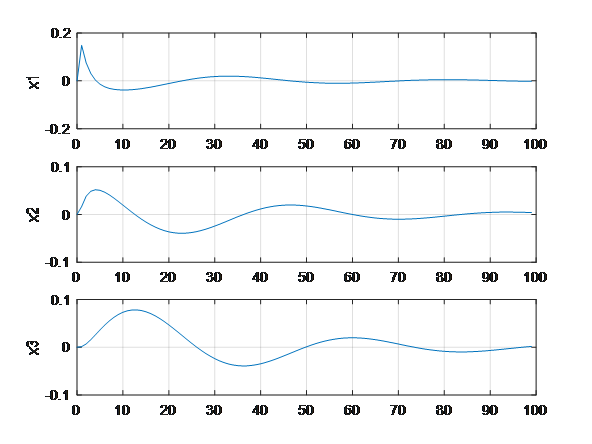
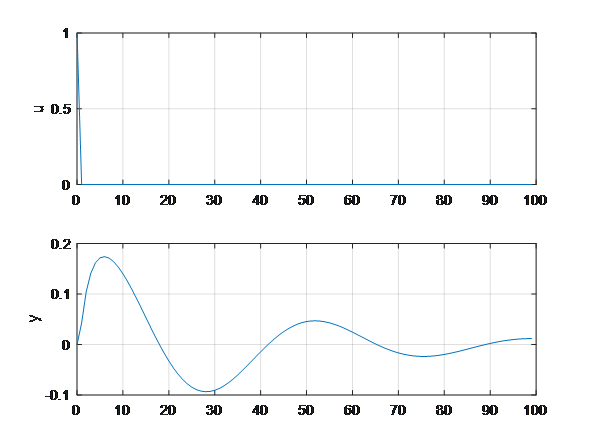
化成离散系统后,仍然稳定。 -
相关阅读:
WindowManagerService详述
台湾大学李宏毅:图解卷积神经网络CNN
八大学习方法(金字塔模型、费曼学习法、布鲁姆学习模型)
如何提高FPGA的逻辑利用率与资源效率!!!
Linux系列之重定向操作
NoSQL之Redis配置与优化
UOS安装Jenkins
4. 线性回归以及基础优化算法
TouchGFX之二进制翻译
内网渗透学习 day1
- 原文地址:https://blog.csdn.net/weixin_40857506/article/details/133943259
